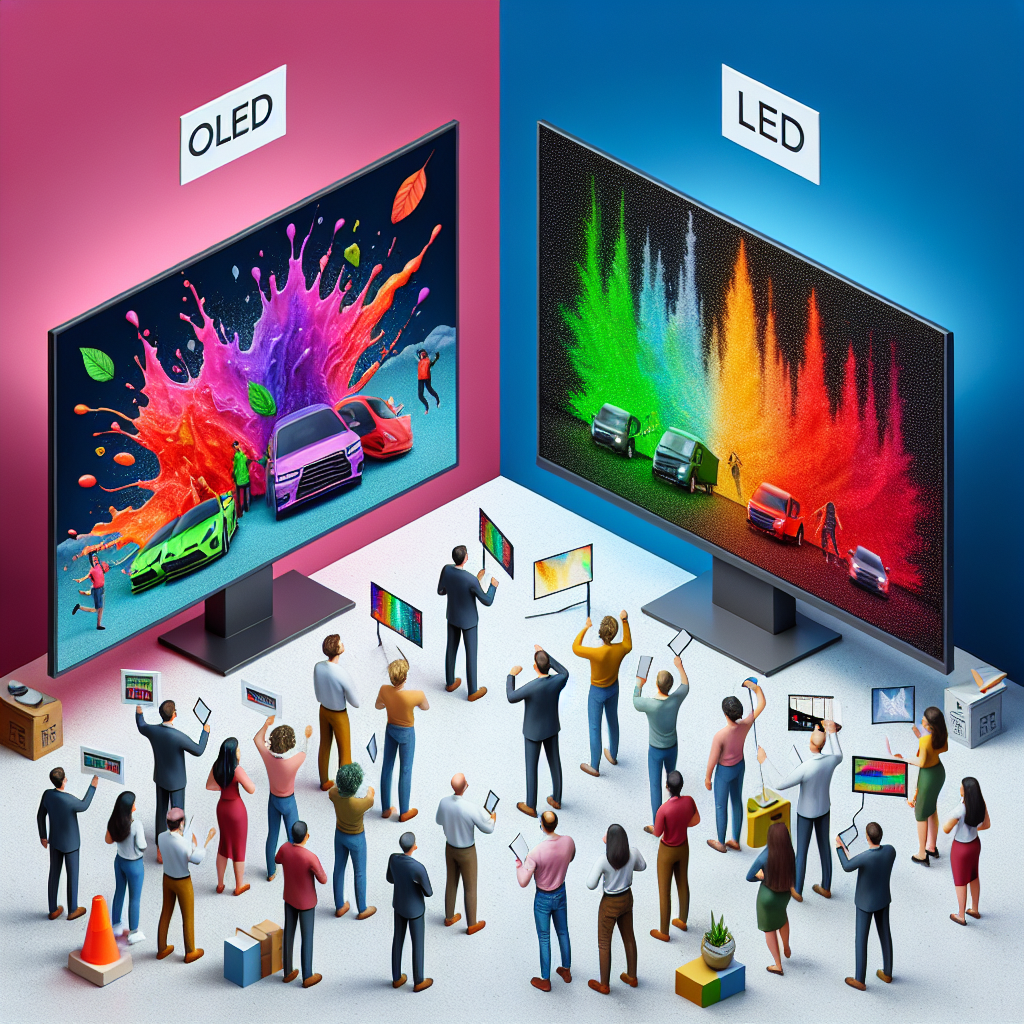The debate over whether OLED monitors are superior to LED monitors has been a hot topic among tech enthusiasts and professionals alike. Both types of monitors have their own unique advantages and disadvantages, making the choice largely dependent on individual needs and preferences. This comprehensive article will delve into the technical aspects of OLED and LED technologies and analyze their performance across various parameters to help you make an informed decision.
Before exploring the specifics, let’s take a look at a comparative table that highlights the main differences between OLED and LED monitors.
| Parameter | OLED | LED |
|---|---|---|
| Technology | Organic Light-Emitting Diode | Light Emitting Diode – backlight required |
| Black Levels | Perfect black levels (individually lit pixels) | Good, but depends on backlight control |
| Color Accuracy | Excellent | Very Good |
| Brightness | Lower | Higher |
| Energy Efficiency | More efficient for dark images | Less efficient, as backlight is always on |
| Cost | Higher | Lower |
| Longevity | Potential burn-in issues | Longer lifespan |
Understanding OLED and LED Technologies
What is OLED?
OLED stands for Organic Light-Emitting Diode. Unlike traditional LED monitors, OLED screens do not require a backlight. Each individual pixel in an OLED display is a small, organic compound that produces its own light when an electric current passes through it. This allows OLED monitors to achieve perfect black levels, as individual pixels can be turned off completely.
What is LED?
LED stands for Light Emitting Diode. LED monitors use a backlight to illuminate the pixels on the screen. The backlight is typically made up of several LEDs. An improvement over older LCD technology, LED monitors offer better brightness and energy efficiency. However, the need for a backlight can affect black levels, as some light leakage is inevitable.
Key Comparisons Between OLED and LED Monitors
Black Levels and Contrast
OLED: OLED monitors excel in producing perfect black levels, which in turn contribute to infinite contrast ratios. This is because each pixel can be turned off individually, creating true blacks without any light leakage.
LED: LED monitors, on the other hand, can struggle to achieve perfect black levels. Despite advanced local dimming techniques, some light leakage is usually present, affecting the overall contrast ratio.
Color Accuracy
OLED: When it comes to color accuracy, OLED monitors are hard to beat. They offer extremely vibrant colors and can display a wider color gamut compared to LED monitors. This makes OLED an excellent choice for professional work like photo and video editing.
LED: LED monitors also offer good color accuracy, but they generally fall short compared to OLED. Higher-end LED monitors can come close, thanks to technologies like quantum dots, but they still lack the overall vibrancy of OLED screens.
Brightness
OLED: One of the drawbacks of OLED technology is its lower peak brightness compared to LED monitors. OLED screens are typically less bright, which can be an issue in well-lit environments.
LED: LED monitors have an advantage in terms of brightness, making them more suitable for use in brightly lit rooms or for HDR content that requires high peak brightness.
Energy Efficiency
OLED: OLED monitors are more energy-efficient when displaying darker images since individual pixels that are turned off do not consume power. However, they can consume more energy when displaying bright images because all the pixels need to be lit.
LED: LED monitors tend to consume more energy overall because the backlight is always on. Improvements have been made over the years to enhance their energy efficiency, but they still lag behind OLED in this regard.
Cost
OLED: The high cost of OLED monitors is a significant drawback. The complexity of producing OLED panels and their organic nature contribute to higher prices, making them less accessible to the average consumer.
LED: LED monitors are generally more affordable and come in a wide range of sizes and features, making them a more budget-friendly option for many consumers.
Longevity
OLED: One of the major concerns with OLED technology is the potential for burn-in. This occurs when static images are displayed for long periods, causing the affected pixels to degrade faster. While modern OLEDs have mitigated this issue to some extent, it remains a concern.
LED: LED monitors are less prone to burn-in and generally have a longer lifespan compared to OLED screens. This makes them a more reliable choice for applications requiring long-term usage.
Which One Should You Choose?
Best for Gaming
If you’re an avid gamer, you may benefit more from an OLED monitor. The perfect black levels and fast response times provide an immersive gaming experience. However, keep in mind the potential for burn-in with prolonged static images like HUDs or game menus.
Best for Professional Use
For professionals working in fields such as graphic design, video editing, or photography, OLED monitors offer superior color accuracy and contrast. The vibrancy and precision of colors make a noticeable difference in work quality.
Best for General Use
For general use, including web browsing, office work, and casual media consumption, an LED monitor is often the more practical choice. They are more affordable, have sufficient quality for most users, and offer longer lifespans without the burn-in concerns associated with OLED technology.
Future Prospects
OLED technology is continually improving, and many of its current drawbacks, such as cost and potential burn-in, are being addressed. As manufacturing processes become more efficient and new innovations emerge, it’s likely that OLED monitors will become more accessible and practical for a wider range of consumers.
LED technology is also evolving, with advancements like Mini-LED and Micro-LED promising to close the gap with OLED in terms of black levels, contrast, and color accuracy. These technologies aim to offer the best of both worlds, bringing higher brightness and longer lifespans without sacrificing picture quality.
Conclusion
The choice between OLED and LED monitors ultimately depends on your specific needs and budget. OLED monitors offer exceptional black levels, color accuracy, and contrast, making them ideal for gaming and professional use. However, they come at a higher cost and have potential longevity issues. On the other hand, LED monitors provide higher brightness, better affordability, and longer lifespans, making them a practical choice for most users. Consider your priorities and preferences to determine which type of monitor is the best fit for you.

